Tennessee Truffles and a Tennessee Corn and Truffle Flan
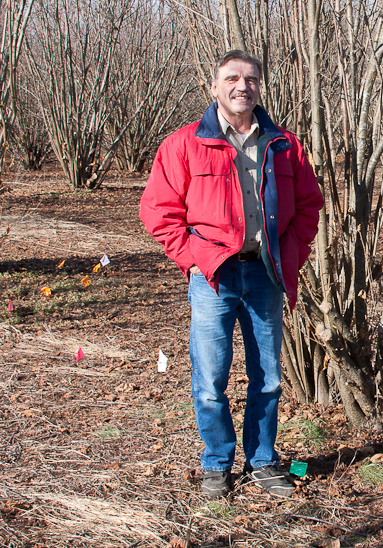
The Lagotto Romagnolo is the traditional truffle hunting dog that originated in Italy. The dogs are a better option than the pigs (that were originally used to truffle hunt) since they will not eat the truffles as the pigs do. During our visit, I was able to speak with Hilarie Gibbs-Sykes, who was one of the first breeders to bring the Lagotto Romagnolo to the U.S.
She told me that these dogs are raised from in vitro to sniff out truffles! The pregnant bitches are fed truffles while they are carrying their litter and then truffle oil is placed on their teets while the pups nurse as well as adding it to their food. Trainers also cover rags in truffle scent and bury them so that the dogs will dig to find the truffles.
Tom prefers cats, so when it is time to go truffle hunting (several months during the Winter), he will borrow a dog from Hilarie. They tragically lost one dog recently and are in the process of bringing another over from Italy. While we were visiting, Tom brought a dog in from Arkansas to hunt. While not a Lagotto, Daisy was certainly productive. Stuart Davis, Daisy’s handler, has trained Daisy to hunt for truffles the same way the Lagotto has been trained. Isn’t she cute???
How long will Tom keep doing this? My bet is as long as he can. The weather this year was difficult for his truffière. The temperatures were colder than normal, so it was hard to keep up with the demand for the truffles. Tom said that over the last few months, he has also received between three to four new calls a day looking for truffles. The demand is so far ahead of the supply.
We asked him about the popularity of growing truffles in North Carolina (his next door neighbor) and if that will come to fruition. He said that right now there are very few successful truffle farmers that can produce what he is doing. Tom joked that there may be more truffle dogs in North Carolina than commercial truffles, but he expected more orchards to produce commercial truffles in the future.
Although it took California forty years to be recognized to produce a wine comparable to that which comes out of France, this has not been the case with Tom’s truffles (as well as some other U.S. grown truffles). His truffles have been hand-carried to France three times to “grudgingly favorable reviews”. One of those times Peter Yuen of Chicago, took second place at the 2010 Baking Masters in Paris, France using these truffles in his brioche.
The advantage to growing these truffles in the U.S. is that it is a local food and sustainable. The product is fresher. It can reach the chefs within a day or two of being harvested versus weeks if it’s shipped from Europe.
Tom also envisions creating a route at some point where he can personally travel and deliver his truffles to many of the regional chefs (he does that to a certain extent now, especially when he goes to Asheville). He likes the idea of the chefs being able to see the truffles and smell them before they purchase them, as each truffle can have a unique characteristic. He said that he loves empowering the chefs with this “u-pick” approach.
As Tom works on a business plan to significantly expand the number of truffle trees, I know that he will succeed. As the truffle becomes a more popular and local ingredient, there will be a large demand for truffles in many levels of quality.
People come from all over the world to meet and speak with Tom about his truffle orchards and how he has achieved such great success. In fact, there was a gentleman from Australia visiting with him just this past week. Just as most chefs are willing to share their recipe with you, many of them will leave out that special ingredient that makes the real difference in the final dish. My bet is that Tom is keeping that certain secret ingredient to his Périgord truffles to himself.
We visited Tom in mid-December, but waited until now to order one of his Périgord Truffles to try for ourselves at home. It has made it’s way into several dishes and it has been adding to the fragrance of our home every time we remove it from the refrigerator.
The characteristics have changed over the few days we have had the truffle. It reminds us of a great bottle of wine in that it evolves with time. The wine will smooth out and emit soft, pleasing aromas as it oxidizes. The truffle evolved in the same way. After we cut the truffle, the bouquet opened up and continued to change each time we have used it. It has become more pleasing. The aroma and the taste is musky, earthen, but yet somewhat sweet. The truffle will evolve for almost one week before, like a bottle of wine, it declines.
We have been doing some testing and playing in the kitchen with this prized 1.4 ounce Périgord Truffle possession, so there will be lots more to come!
Here is a recipe that originally was created by Tom and his girlfriend, Vicki. The adapted version made it’s way to The New York Times and eventually into the Blackberry Farm cookbook.
Enjoy!
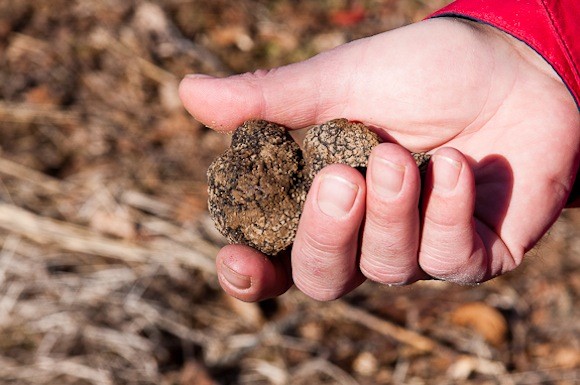
Tennessee Corn and Truffle Flan
Adapted from Tom Michaels
Ingredients
- 1/4 cup flour
- 1/2 cup fine cornmeal
- 1 tablespoon sugar
- 1/4 teaspoon baking soda
- 1/8 teaspoon sea salt
- 2 cups fresh or frozen corn kernels
- 1/2 cup unsalted butter, melted
- 2 large eggs, beaten well
- Dash of cayenne pepper
- 2 cups sour cream (I used Daisy low-fat sour cream)
- 1 cup grated Parmesan cheese
- 1 to 2 ounces finely shaved fresh black winter truffle
Instructions
1. Preheat oven to 325 degrees. In a bowl, combine flour, cornmeal, sugar, baking soda and sea salt. Set aside. If using frozen corn, make sure it is well-defrosted and drained.
2. Warm a nonstick skillet over high heat and toss corn in to dry and toast slightly. In a bowl, combine cooked corn with 7 tablespoons melted butter, the eggs, cayenne and sour cream. Using a few swift strokes, add dry ingredients. Stir in cheese and shaved truffle, reserving just enough truffle to garnish flan before serving.
3. Use remaining tablespoon butter to grease 8 6-ounce ramekins. Spoon mixture into ramekins, cover each with foil and place in a baking pan. Add boiling water to pan until it reaches halfway up ramekins. Bake for 25 minutes. Remove from oven and allow to rest, covered, for 10 minutes before serving. Flan can be served, garnished with additional truffle slices, in ramekin or loosened and turned out on a plate.

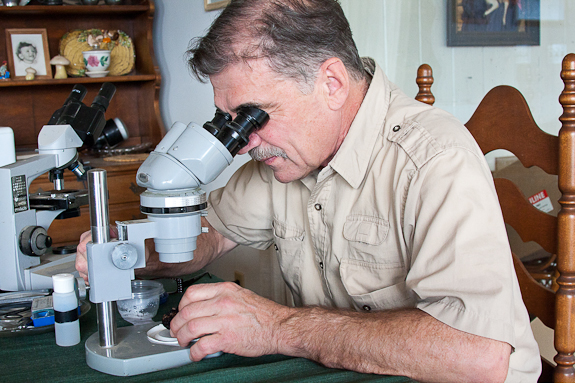


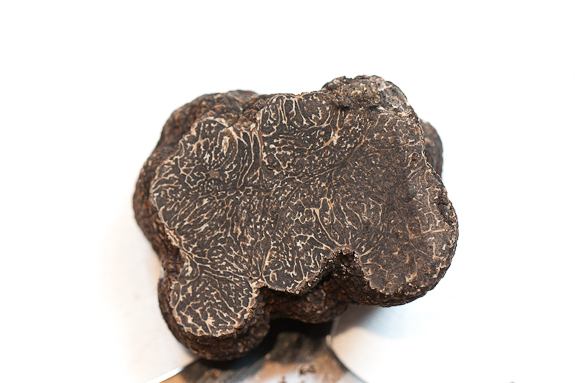

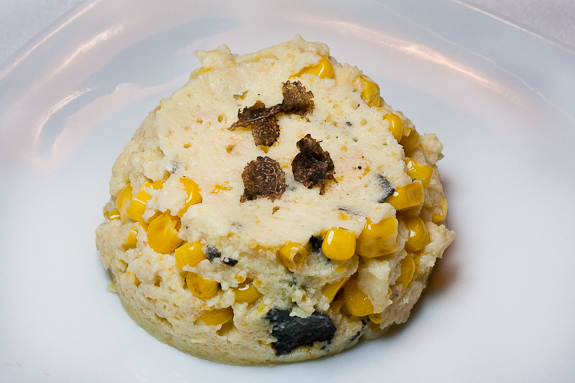
















Oh my word, Gwen! I need to head on up to Tennessee!!!
Hi Robyn,
Yes, you do!! 🙂
Gwen
Very timely! That cute Newfie puppy I just visited is owned by our friends who started a truffle farm a few years ago in North Carolina. Things seem to be moving along as planned in her venture! Tom appears to be quite the expert! Peter Yuen’s Brioche with Truffles looks heavenly, as does the corn and truffle flan. Cancel all those other requests for you to slip lemon curd and limoncello in your suitcase and slip in one of those truffle bad boys instead.
Hi Denise,
Maybe I can slip some goodies in if you consume them before your flight back home! The TSA would certainly have issues with something that looks and smells like this! 😉
Gwen
Wonderful and informative post, Gwen! Sounds like a great trip, and I love to hear about local farmers doing what they love best. Thanks!
Hi Carolyn,
Thank you. These are my favorite posts to do from meeting the people to writing and publishing them. Glad you enjoyed it.
Gwen
Such an exciting post about these marvelous truffles and right on our doorstep! Thanks Gwen!
Hi Maria,
Yes, they are very close by and they are fabulous. Tom really has mastered the art of growing truffles!
Gwen
I think I just found a reason to take a trip to Tennessee. Great post Gwen! Fascinating!
Thank you, Brian. Yes, it would certainly be worth a trip to Tennessee!
Wow. What a fun day. And beautiful food too!
Thank you, Amy. Maybe I can bring some to Savannah! 😉
Seems they’re beginning to have success growing truffles all over the US. Yay…now the rest of us can finally afford some.
Your flan looks and sounds divine!
Hi Pamela,
They aren’t cheap, but they sure are good! It is well worth the splurge once in awhile to have an ingredient this luscious to play with in some dishes.
Gwen
I had no idea that the U.S. could produce a high quality truffle before reading this post. Wow! Thanks for sharing this with your readers.
Velva
Hi Velva,
Thank you for your comment. It is amazing that the U.S. is doing this now and I feel fortunate to have been able to share this article on my site. I am glad you enjoyed it.
Gwen
That was a very informative post and the flan looks tremendous. Bookmarking this for sure.
Hi Sue,
Thank you for your comment and the flan is a must make if you find yourself with some Perigord truffles!
Gwen
Amazing! I had no idea that truffles were being cultivated in North Carolina. They look like high quality truffles.
Hi Christine,
Yes, they are very high quality truffles. North Carolina is also producing some, but Tennessee is where these were from.
Gwen
I live in TN and had no idea this existed! Thanks for sharing…great post 🙂
Beth,
Thank you for the comment. It is pretty nifty to discover these are growing practically in your backyard!
Gwen
…fascinating and very informative interview with Tom…I prefer black over white truffles and place the black variety in my special mashed potatoes….
Did you say truffled mashed potatoes? Oh, my! We may have to get your recipe for those! 🙂
wonderful post—informative,
and very exciting, since I live in Tennessee! many thanks–
Nancy,
Thank you for the comment. I know lots of people are really happy to have discovered these are practically local food!
Gwen
Great post! I would love to head up to Tennessee and check this place out!
Casey,
I think lots of people may be headed to Tennessee to check this out! Thank you for your comment.
Gwen
maps… dot… google…dot…com……. chuckey…
LOL! Hit “Go”!
Oh my Gwen I so enjoyed this post! Extremely interesting and as always, beautifully displayed. I can understand him wanting the chefs to hand pick the truffles, especially after reading your personal description of their ever changing flavor.
Have a great weekend!
Kathy,
Thank you so much for your comment. I am glad that you enjoyed the article. We spoke to a chef yesterday that thoroughly agreed with our description of the truffle and the way it changed over several days. I can also understand why they would want to be able to choose their truffles and how it influences the way they use them in their cooking.
Gwen
This story is utterly fascinating! I knew (living in France and Italy) that pigs and dogs were used to hunt truffles but I had no idea the way the dogs were trained to know and love the scent. Wow! What a great post! We rarely eat truffles but funny enough husband ordered the truffle omelet when we went out for my birthday. Didn’t even offer me a taste. Your flan is so tempting!
Jamie,
Shame on your hubby! Doesn’t he know how to share? 😉 Yes, it really was fascinating to learn how the dogs are trained. We learned so much from this trip.
It truly was fascinating and Tom is delightful.
Gwen
Wow – such an interesting story (and with the TMI piece, every man in America is now out shopping for truffles, I’m sure!)
Thanks for sharing such an informative post!
Hi Kristen,
Yes, every man should be out shopping for truffles after reading this! I never knew…that’s for sure! Glad you enjoyed the article.
Gwen
great, great post Gwen – to say that i’m SHOCKED at truffle-growing in the US is an understatement – who knew??? i had no idea there was such a thing as a ‘truffle tree’, had no idea how the dogs were trained to hunt truffles and certainly had no idea about the TMI on truffles . . . huh. i have purchased truffle butter and use it with pasta – DIVINE! i may just have to order one of these and give it a try!
Hi Debra,
That is what is fun about these types of article.s I never knew truffles were growing on this side of the country until we heard about Tom and his truffles last Summer. It is amazing that they are right in our backyard and that they are fabulous!
Gwen
Road trip! Fabulous post – thanks for sharing this Tennessee find! Truffle trees – who knew? That corn and truffle flan is amazing.
Thank you, Priscilla. Yes, it was a great find and the flan is a must make dish!
Fantastic article, Gwen! I had no idea that there was a bounty of truffles in Tennessee – what a find! The flan sounds like a wonderful way to highlight the flavor.
Thank you, Dara! It was an awesome find as well as making a new friend in Tom. BTW, you should definitely try the flan. It was a lovely (and rich!) side dish.
Another amazing article. You should collect these and publish them. They are some of my favorite blog reads! I knew very little about truffles before reading this post, and now I’m hankering to go to Whole Foods, purchase some truffles and try these beauties for myself. Thank you for sharing another passionate foodie with me.
Hi Monet,
Thank you so much for your comment. These are my favorite posts as well. It is so much fun to meet the people behind the food and get to write these articles.
Gwen
What a great article – You really ought to write for the newspaper. Look at the amount of research you put into these. And here I thought the only ones that can sniff out truffles are pigs! Goes to show how much I know 🙂
Sorry I’ve been out of circulation but good to be back for such a lovely looking flan.
chow! Devaki @ weavethousandflavors
Hi Devaki,
Thank you! Does the newspaper pay more than blogging? 😉
I knew there were truffle dogs, but did not know how they were trained. That was fascinating as was the whole visit to Tennessee Truffles.
I really hope that things are better for you and your family now.
Gwen
Hi Devaki,
Thank you! Does the newspaper pay more than blogging? 😉
I knew there were truffle dogs, but did not know how they were trained. That was fascinating as was the whole visit to Tennessee Truffles.
I really hope that things are better for you and your family now.
Gwen
I had no idea that there were truffles in TN! How fun! And your flan looks wonderful. The richness of the truffles and the sweetness of the corn must be wonderful!
Oh lordy, wish this man was my neighbor!! What a unique profession to get into – he must be a celebrity among celebrity chefs! Will he do tours? We’re trying to plan a trip to TN, would LOVE to check this out for ourselves… 🙂
[K]
Hi Kim, If you head South, we will offer to be your personal tour guide! 😉
hi Gwen
you did get to meet some of the most interesting people around! I knew we had truffles in this country but I never realized where they came from. Thanks for all the info in a really great post!
hope the weather is treating you better
Dennis
This is a fantastic post, Gwen. I had no idea. I hope i get to try them someday!
Gwen and Roger,
Great article and photos on the truffles. It’s amazing how the truffle dogs are groomed from birth.
Keep up your great passion and hobby, it’s so interesting to learn about these culinary secrets!
Kimberly
Would like to visit your farm. Possibly get some Truffle tips for our bloodhound Amos.
http://youtu.be/67WnlNXLtso
Hi Dave,
You actually need to get in touch with Tom Michaels at Tennessee Truffle. http://tennesseetruffle.com/shop/.
Good luck with Amos.
Gwen